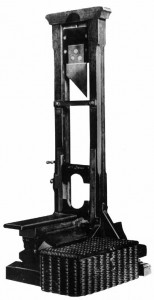guil•lo•tine –noun

 1. a device for beheading a person by means of a heavy blade that is dropped between two posts serving as guides: widely used during the French Revolution.
1. a device for beheading a person by means of a heavy blade that is dropped between two posts serving as guides: widely used during the French Revolution.
2. any of various machines in which a vertical blade between two parallel uprights descends to cut or trim metal, stacks of paper, etc.
Origin:
1785–95; named after J. I. Guillotin (1738–1814), French physician who urged its use
Disclaimer: C Marshall Fabrication Machinery in no way condones beheading, and in no way, shape or form should any of its offerings be interpreted for such or similar uses.
Although the guillotine should by no means be confused with the guillotine shears sold here at C Marshall Fabrication Machinery, their basic mechanical functions can both be traced to the same origins.
Many of us are familiar with the gorgeous irony of the Nobel Peace prize, which was established by the Swedish chemist Alfred Nobel – whose original claim to fame was his invention of dynamite.
However, although its story is just as ironic as that of the Nobel Peace Prize, the history and namesake of the original guillotine is not widely known.
Most commonly associated as a bloody icon of the horrors of the French Revolution, the guillotine was originally invented by Doctor Antoine Louis, the Secretary of the Academy of Surgery in France. Its purpose was to devise a machine that would basically kill people equally. More specifically, the dawn of the French Revolution also happened to coincide with the Age of Enlightenment, which was sweeping through not only France but all of Europe at the time. As part of the restructuring of the French government, it was reasoned that a standardized and swift method of execution should be made readily and uniformly available throughout France. Also in keeping with the “enlightenment” of the times was the desire for a less painful and less torturous form of execution.
Enter Dr. Joseph-Ignace Guillotin, a big fan of Voltaire and Locke, and a champion of “humanitarian” forms of execution.
Originally laughed out of France’s new Legislative Assembly for his peace-loving, hippie-dippy beliefs (the French still preferred lots of blood, guts and noisy screaming when it came to their justice procedures), Dr. Guillotin proposed that decapitation should become the sole method of execution in France. The machine he proposed for the job was a prototype of Dr. Antoine Louis’ handy-dandy decapitation machine, which even included a privacy screen for enhanced dignity of its soon-to-be headless customers. Guillotin’s proposal was, in fact, ahead of its time in that it advocated, for the first time in France’s history, a fast and painless method of execution that was egalitarian, regardless of background, social status, age, sex or rank: in short, it was seen as an embodiment of such enlightened concepts as humanity and equality.
If Death is the great Equalizer, then the guillotine was its first true enforcer.
In spite of his lofty ideals, once Guillotin’s proposal took hold in actual French law, his name became irrevocably associated with rolling heads, and thus the name “guillotine” was born. Dr. Guillotin’s children, who were none too thrilled by this association, respectfully requested that the French government change the name of the beheading machine. Although the government wouldn’t concede to their request, it did offer them the option of changing their own names – which they did, to distance themselves from the icon of execution that had become their namesake.
The fact that guillotine shears still to this day operate on the same basic principles as the original beheading machine is a testament to their functionality of design. In this sense, at least, the Age of Reason seems to have prevailed. After all, “if it ain’t broke, don’t fix it”; and as long as you read the instructions, you probably won’t lose your head using one.
-Anja Wulf
